|
Computer,
GPS and other
Hardware and Software
After many years of research in
the PaleoSeti field I gathered some useful Soft- and Hardware you might
find
handy if you do your own research.
A major part of course is my
camera equipment that I described here.
The other big part is my mobile computer and accompaning software. I
maintain
an electronic database of PaleSeti related Images, texts, books and
movies that
has grown to over 100GB over the years. Thankfully mobile computers
have come
a long way and pretty much all sizes are available from handheld to 21
inch
screens.
The computer I use at the moment is a Lenovo Thinkpad T420s which is a
sturdy and relatively lightweight laptop. What I like about the T420s
is the fact that everything is very modular and easliy exchangeable.
Even a second battery or hard drive can be fitted. The computer houses
a 1TB harddrive which is ample room for my database (see below), image
editing and backup on the go. The computer runs Windows 7.
Much more important then computer hardware is the software it runs.
Software
Data
archiving and research
For my own research I compiled
a database of images, movies and texts that I feel are important for
the PaleoSeti Theory. Over the years this database grew well over 100
Gigabytes in size and houses over 40000 items. I'm trying to downsize
images to a maximum of 2 megapixels to keep file sizes small. I tried
several database programs, but over time I realized that having a
simple, very organized file structure is the way to go. This way the
database is compatible across all computer plattforms and operating
systems. As you can imagine I changed computer systems often since I
started the database on a 80286 PC back in 1989.
|
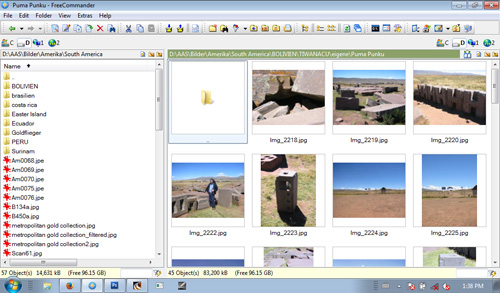
|
The database is too complex to
show here in detail, but it's basically nothing else but a large
structure of files, folders and subfolders that's organized by file
category, continents, countries etc.
The program that helps me with this task is
"Free Commander", a freeware application that is one of the
most flexible pieces of software for file organisation on the market.
It is modeled after the old Norton Commander from the old days of
MS-DOS. Once you get used to Free Commander (or any other piece of
software that emulates the Norton Commander) you will never go
back to anything else. It's very efficient and comfortable to use.
|
|
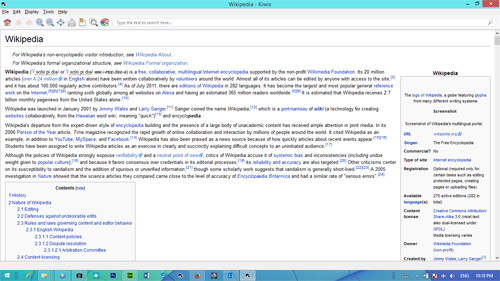
|
Everybody knows Wikipedia
nowadays. Many complain that it is not always accurate, but in recent
years it has become a pretty good, accurate resource if you want to
look up, well, pretty much anything. The trouble with Wikipedia is that
you have to be online in order to access it.
What most people don't know is that there is a method to have the
complete Wikipedia database on your computer as an off-line readable
and searchable resource.
The program that make this possible is called
Kiwix.
Every year the complete Wikipedia Database is made available as a so
called "dump" and you can download it and read it with the Kiwix
reader. The complete text version of Wikipedia in English is currently
26 GB. Since I'm bilingual I also have the German version installed
which is another 14GB. For quick research Kiwix is a fantastic tool.
|
|
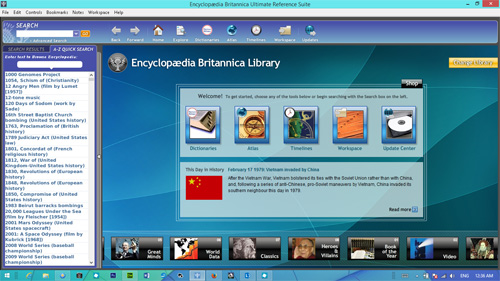
|
The commercial counterpart to
Kiwix is the Encyclopedia Britannica, pretty much the only Encyclopedia
left next to Wikipedia these days. The Britannica is updated every
year, and has great, indepth texts from very reliable sources.
Unfortuntely it can't compete with Wikipedia's enormous volume and
number of entries. I find the use of both Encyclopedias useful and one
does compliment the other. The Britannica costs around $50 in it's
current edition. A tip for budget minded people is last year's version
that can be had for $10.
|
|
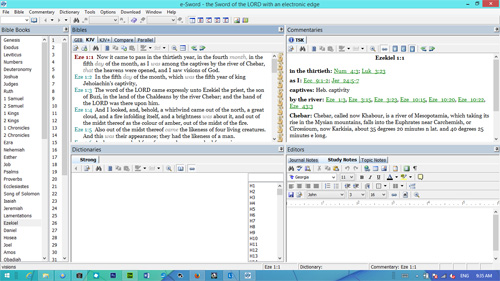
|
If you are interested in
PaleoSeti research you will sooner or later read ancient texts. One of
the texts is - of course - the bible. It's riddled with hints of an
extraterrestrial contact in the past. A paper copy will do just fine,
but much more elegant and convenient for research is good Bible
software that lets you compare different bible version and languages
with one click. The best Bible software I found is eSword.
It's completely free. They have many different bible versions to
download free as well.
|
Astronomy
Many ancient sites are
astronomically aligned. To check out what the ancient people had in
mind you need accurate Astronomy software that is able to calculate the
starry skys back thousands of years
|
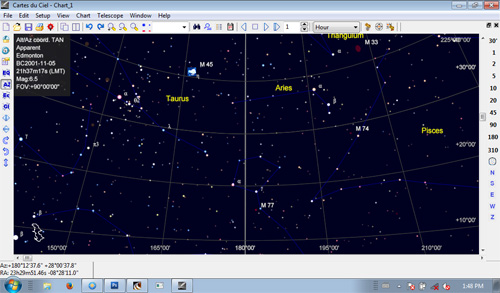
|
My favourite Astronomy software
by far is the no frills and completely free "Cartes Du Ciel - Sky
Charts". The Program is fast and does exactly what it's supposed to:
Displaying the stars. You can download it here.
Yes, you can spend a lot of money on other software like "The Sky X"
which looks very pretty, but I would rather spend the $300 saved on a
telescope like the Meade ETX and look at the real thing.
|
|
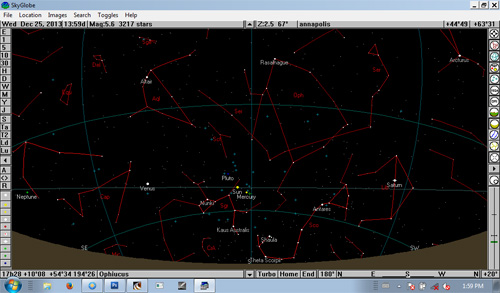
|
During the MS-DOS years
(remember those?) there was a famous piece of software called
"Skyglobe". For many years it was THE choice for any researcher that
wanted to go back thousands of years and see what the skies looked like
back then. Robert Bauval and Graham Hancock used it to do their
research back in the early 1990s. Unfortunately the old MS-Dos version
doesn't run natively anymore ever since Windows 7. You will need a DOS
Emulator like DOS Box to run it. The maximum resulotion you can get it
to run is 640x480 which isn't very satisfying on today's PCs. For
nostalgic reasons I offer it for download here. (Skyglobe 3.6 for
DOS)
What most people don't know is that there was a very short lived
version of Skyglobe for Windows 95 that still runs perfectly on Windows
7 but not on Windows 8.
This program is basically impossible to find now. I have it on my
harddrives ever since it came out. I have a feeling I'm the only one
left that has a copy. The program was shareware back then and I don't
think the author has a problem if I offer it here for download as well.
(Skglobe for
Windows)
|
|

